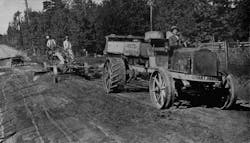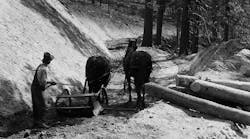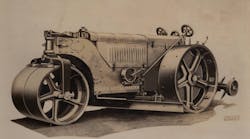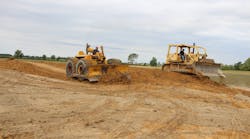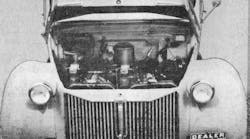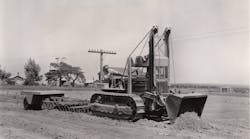In the late 1880s, America’s roads were rarely more than dirt tracks that were impassable in inclement weather. As bicycles and, later, automobiles came into widespread use, however, the demand grew for roads capable of safely and efficiently handling increased traffic. The campaign to improve the nation’s streets and highways came to be known as the Good Roads Movement (see Equipment Echoes Issue 84) and was in its heyday in the 1910s and 1920s.
Longtime National Construction Equipment Museum volunteer Dave Brainard is an expert on White trucks, and his literature collection includes a wonderful catalog titled White Good Roads Trucks. Published in 1916, the catalog markets a heavy-duty truck that White produced specifically for road-improvement projects. This essay and accompanying photo are from the catalog; the author thanks Dave for its use.
What the catalog’s photos cannot tell, however, are the Good Roads Truck’s many advantages over a team of mules or horses. White reported that the Good Roads Truck typically cost $250 to $400 a month to operate, whereas the cost of a team of two mules with driver is given in the catalog at about $65 per month; the truck, however, according to the catalog, could do the work of 15 such teams on average.
In a study by Washington County, Miss., the hire of 20 mules and six men, plus feed for the mules, cost $39 per day; gasoline and oil for one truck, plus hire of four men, cost $11.50 day. In Early County, Ga., one truck covered 55 miles per day with two pull-behind graders (work that would have required four teams) for less than the cost of feed for the mules.
Montgomery County, Ala., with a fleet of six Good Roads Trucks, reported that the entire county road system could be reworked after each rain with one truck and three “scrapers” (probably pull graders and/or road drags) for $0.45 to $1.26 per mile; reclaiming gravel roads could be accomplished for $40.00 per mile. One stretch of road was scarified and reshaped for $24.06 per mile, compared with $400.00 per mile by other means, which presumably involved teams.
Mules and horses also had to be rested for intervals that often were as long as their work periods. In addition, they were much less productive in hot weather, had to be fed and watered (with corresponding costs) whether they worked or not, and were subject to sickness and death.
The truck, on the other hand, avoided these drawbacks. One county road superintendent attested to the vast improvement in availability in memorable terms: “It is as regular as any trustee in the chain gang—always on the job.”
And, the truck required fuel, oil and maintenance only if it worked, eliminating the teams’ cost of upkeep during downtime. Teams were also limited in how far from a base of operations they could work, because transporting them significant distances was impractical. The truck solved this problem via its superior mobility, allowing roads far removed from the yard to be maintained.
The Historical Construction Equipment Association (HCEA) is a 501(c)3 non-profit organization dedicated to preserving the history of the construction, dredging and surface mining equipment industries. With more than 4,000 members in 25 countries, our activities include operation of National Construction Equipment Museum and archives in Bowling Green, Ohio; publication of a quarterly magazine, Equipment Echoes, from which this text is adapted, and hosting an annual working exhibition of restored construction equipment. Our 2016 show is September 16-18 at our National Construction Equipment Museum in Bowling Green, Ohio, USA. Individual memberships are $35 within the USA and Canada, and $45 US elsewhere. We seek to develop relationships in the equipment manufacturing industry, and we offer a college scholarship for engineering students. Information is available at www.hcea.net, or by calling 419.352.5616 or e-mailing [email protected].
